Experimental Comparison of Water-Based Cooling Methods for PV Modules in Tropical Conditions
Abstract
1. Introduction
2. Experimental Facilities and Methods
3. Results and Discussion
3.1. Testing the Power Conversion Efficiency of the PV Modules
3.2. Effect of Surface Temperature on PV Performance Power Conversion Efficiency
3.3. Effect of Cooling Methods on PV Performance
3.3.1. The Effect of Spraying Liquid Method (SL) on PV Performance
3.3.2. The Effect of Tube Heat Exchanger Method (TE) on PV Performance
3.3.3. The Effect of Dripping Droplet Method (DD) on PV Performance
3.3.4. The Effect of Liquid Flowing on the PV Surface (LF) on PV Performance
3.4. Comparing the PV Performance of Four Active Cooling Methods
4. Conclusions
Author Contributions
Funding
Data Availability Statement
Acknowledgments
Conflicts of Interest
Abbreviations
| PV | Photovoltaic |
| SL | Spraying liquid |
| DD | Dripping droplet |
| TE | Tube heat exchanger |
| LF | Liquid flowing |
| Voc | Open-circuit voltage |
| Isc | Short-circuit current |
| CPV TJ | Concentrator triple-junction solar cells |
| PCE | Power conversion efficiency |
References
- Sharma, V.K.; Monteleone, G.; Braccio, G.; Anyanwu, C.N.; Aneke, N.N. A Comprehensive Review of Green Energy Technologies: Towards Sustainable Clean Energy Transition and Global Net-Zero Carbon Emissions. Processes 2025, 13, 69. [Google Scholar] [CrossRef]
- Liu, Z. Chapter 6-Innovation in Global Energy Interconnection Technologies. In Global Energy Interconnection; Liu, Z., Ed.; Academic Press: Cambridge, MA, USA, 2015; pp. 239–272. [Google Scholar] [CrossRef]
- Ju, X.; Xu, C.; Hu, Y.; Han, X.; Wei, G.; Du, X. A review on the development of photovoltaic/concentrated solar power (PV-CSP) hybrid systems. Sol. Energy Mater. Sol. Cells 2017, 161, 305–327. [Google Scholar] [CrossRef]
- Kapsalis, V.; Maduta, G.; Skandalos, N.; Bhuvad, S.S.; D’Agostino, D.; Yang, R.J.; Udayraj, P.D.; Karamanis, D. Bottom-up energy transition through rooftop PV upscaling: Remaining issues and emerging upgrades towards NZEBs at different climatic conditions. Renew. Sustain. Energy Transit. 2024, 5, 100083. [Google Scholar] [CrossRef]
- Solar Power Europe. Global Market Outlook for Solar Power 2025–2029. Available online: https://www.solarpowereurope.org/insights/outlooks/global-market-outlook-for-solar-power-2025-2029/detail (accessed on 12 May 2025).
- Riva Sanseverino, E.; Le Thi Thuy, H.; Pham, M.-H.; Di Silvestre, M.L.; Nguyen Quang, N.; Favuzza, S. Review of Potential and Actual Penetration of Solar Power in Vietnam. Energies 2020, 13, 2529. [Google Scholar] [CrossRef]
- Phap, V.M.; Huyen, C.T.T.; Tung, N.T.; Thao, N.T.N.; Thanh, D.Q. Study on technical, economic, environmental power conversion efficiency of self-consumption rooftop solar power using lithium-ion battery for households in Vietnam. J. Energy Storage 2024, 99, 113446. [Google Scholar] [CrossRef]
- Do, T.N.; Burke, P.J.; Nguyen, H.N.; Overland, I.; Suryadi, B.; Swandaru, A.; Yurnaidi, Z. Vietnam’s solar and wind power success: Policy implications for the other ASEAN countries. Energy Sustain. Dev. 2021, 65, 1–11. [Google Scholar] [CrossRef]
- Vietnam Electricity Corporation, Overview of National Power Sources in 2023. Available online: https://en.evn.com.vn/d6/news/Overview-of-national-power-sources-in-2023-66-142-4147.aspx (accessed on 22 March 2025).
- Koons, E. Vietnam’s Solar Energy Boom: Lighting Up the Future. Available online: https://energytracker.asia/vietnam-solar-energy-boom/ (accessed on 11 June 2025).
- Mar, S.; Bahich, M.; Bentahar, Y.; Afifi, M.; Barj, E. A Study of the Temperature Influence on Different Parameters of Mono-Crystalline Silicon Photovoltaic Module. J. Power Energy Eng. 2021, 9, 29–42. [Google Scholar] [CrossRef]
- Chander, S.; Purohit, A.; Sharma, A.; Nehra, S.P.; Dhaka, M.S. Impact of temperature on performance of series and parallel connected mono-crystalline silicon solar cells. Energy Rep. 2015, 1, 175–180. [Google Scholar] [CrossRef]
- Takyi, G.; Nyarko, F. Investigation of the Effect of Temperature Coefficients on Mono-Crystalline Silicon PV Module Installed in Kumasi, Ghana. J. Power Energy Eng. 2020, 8, 20–34. [Google Scholar] [CrossRef]
- Radziemska, E. The effect of temperature on the power drop in crystalline silicon solar cells. Renew. Energy 2003, 28, 1–12. [Google Scholar] [CrossRef]
- Zaini, N.H.; Kadir, M.Z.A.; Izadi, M.; Ahmad, N.I.; Radzi, M.A.M.; Azis, N. The effect of temperature on a mono-crystalline solar PV panel. In Proceedings of the 2015 IEEE Conference on Energy Conversion (CENCON), Johor Bahru, Malaysia, 19–20 October 2015; pp. 249–253. [Google Scholar] [CrossRef]
- Keddouda, A.; Ihaddadene, R.; Boukhari, A.; Atia, A.; Arıcı, M.; Lebbihiat, N.; Ihaddadene, N. Experimental and numerical modeling of photovoltaic modules temperature under varying ambient conditions. Energy Convers. Manag. 2024, 312, 118563. [Google Scholar] [CrossRef]
- Khamma, K.; Vajpai, J. Performance Evaluation of Different Models of PV Panel in MATLAB/ Simulink Environment. Appl. Sol. Energy 2022, 58, 86–94. [Google Scholar] [CrossRef]
- Dwivedi, P.; Sudhakar, K.; Soni, A.; Solomin, E.; Kirpichnikova, I. Advanced cooling techniques of P.V. modules: A state of art. Case Stud. Therm. Eng. 2020, 21, 100674. [Google Scholar] [CrossRef]
- Hasan, I.A.; Mohammed, M.J.; Attallah, M. Analytical and experimental performance evaluation of direct flow cooling effect on PV panel. AIP Conf. Proc. 2022, 2415, 020013. [Google Scholar] [CrossRef]
- Raju, M.; Sarma, R.N.; Suryan, A.; Nair, P.P.; Nižetić, S. Investigation of optimal water utilization for water spray cooled photovoltaic panel: A three-dimensional computational study. Sustain. Energy Technol. Assess. 2022, 51, 101975. [Google Scholar] [CrossRef]
- Silverman, T.J.; Deceglie, M.; Subedi, I.; Show, S.; Repins, I. Reducing Operating Temperature in Photovoltaic Modules. IEEE J. Photovolt. 2018, 8, 532–540. [Google Scholar] [CrossRef]
- Zhang, G.; Misaran, M.S.; Adzrie, M.; Amaludin, N.A.; Guramun, S. Research on the Passive Cooling System of Solar Photovoltaic Panel Based on Hybrid Solar Chimney and Ventilator. J. Phys. Conf. Ser. 2023, 2655, 012016. [Google Scholar] [CrossRef]
- Refaey, H.A.; Abdelrahman, M.A.; Alharthi, M.A.; Bendoukha, S.; Khan, S.G.; Emam, M. Passive cooling of highly-concentrator triple-junction solar cell using a straight-finned heat sink: An experimental investigation. Case Stud. Therm. Eng. 2022, 40, 102521. [Google Scholar] [CrossRef]
- Nguyen, D.T.; Le, T.H.; Pham, V.H. Long-term performance of rooftop grid-connected photovoltaic systems in central Viet Nam. Int. J. Renew. Energy Dev. 2023, 12, 629–639. [Google Scholar] [CrossRef]
- Sharaf, M.; Yousef, M.S.; Huzayyin, A.S. Review of cooling techniques used to enhance the efficiency of photovoltaic power systems. Environ. Sci. Pollut. Res. 2022, 29, 26131–26159. [Google Scholar] [CrossRef]
- Zondag, H.A. Flat-plate PV–Thermal collectors and systems: A review. Renew. Sustain. Energy Rev. 2008, 12, 891–959. [Google Scholar] [CrossRef]
- Koondhar, M.A.; Albasha, L.; Mahariq, I.; Graba, B.B.; Touti, E. Reviewing floating photovoltaic (FPV) technology for solar energy generation. Energy Strategy Rev. 2024, 54, 101449. [Google Scholar] [CrossRef]
- Menacer, B.; Baghdous, N.E.H.; Narayan, S.; Al-lehaibi, M.; Osorio, L.; Tuninetti, V. Efficiency Enhancement of Photovoltaic Panels via Air, Water, and Porous Media Cooling Methods: Thermal–Electrical Modeling. Sustainability 2025, 17, 6559. [Google Scholar] [CrossRef]
- Sornek, K. Experimental investigation of direct water cooling and cleaning of photovoltaic modules. Energies 2024, 17, 4392. [Google Scholar] [CrossRef]
- Mostakim, K.; Akbar, M.R.; Islam, M.A.; Islam, M.K. Integrated photovoltaic-thermal system utilizing front surface water cooling technique: An experimental performance response. Heliyon 2024, 10, e25300. [Google Scholar] [CrossRef]
- Wibowo, S.; Arifin, Z.; Rachmanto, R.A.; Himawanto, D.A.; Prasetyo, S.D. Optimization of Photovoltaic Performance Using a Water Spray Cooling System with Different Nozzle Types. Int. J. Comput. Methods Exp. Meas. 2024, 12, 9–19. [Google Scholar] [CrossRef]
- Nateqi, M.; Rajabi Zargarabadi, M.; Rafee, R. Experimental investigations of spray flow rate and angle in enhancing the performance of PV panels by steady and pulsating water spray system. SN Appl. Sci. 2021, 3, 130. [Google Scholar] [CrossRef]
- Kaneesamkandi, Z.; Almalki, M.J.; Sayeed, A.; Haidar, Z.A. Passive Cooling of PV Modules Using Heat Pipe Thermosiphon with Acetone: Experimental and Theoretical Study. Appl. Sci. 2023, 13, 1457. [Google Scholar] [CrossRef]
- Rasool, I.N.; Abdullah, R.S. Experimental Study of PV Panel Performance Using Backside Water Cooling Chamber. Int. J. Energy Prod. Manag. 2023, 8, 89–95. [Google Scholar] [CrossRef]
- Ngo, X.C.; Do, N.Y. A comparative study on the performance of rooftop grid-connected photovoltaic systems under tropical monsoon climate in Vietnam. AIP Conf. Proc. 2022, 2534, 020005. [Google Scholar] [CrossRef]
- Eze, V.H.U.; Richard, K.; Ukagwu, K.J.; Okafor, W. Factors Influencing the Power conversion efficiency of Solar Energy Systems. J. Eng. Technol. Appl. Sci. 2024, 6, 119–131. [Google Scholar] [CrossRef]
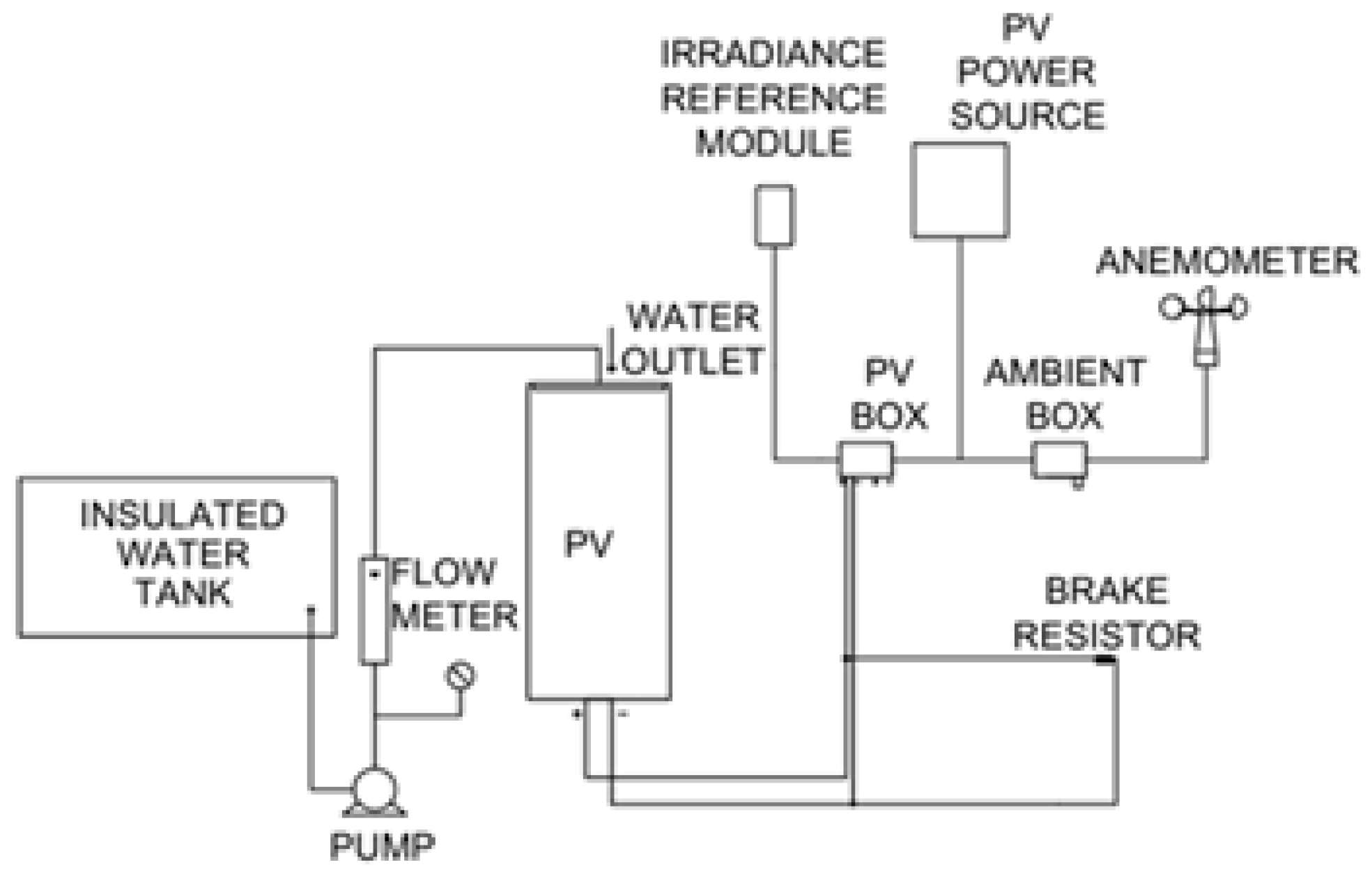

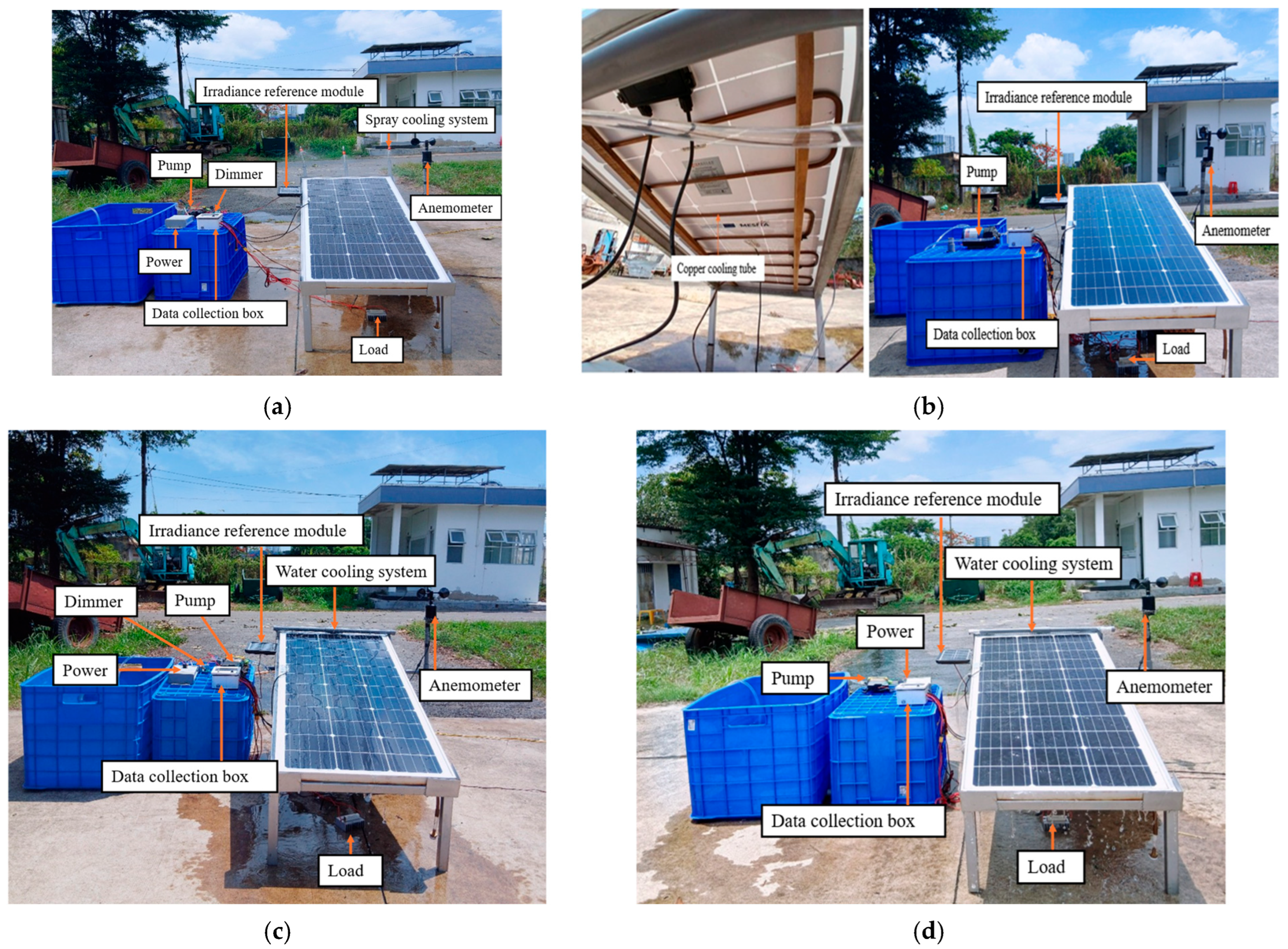
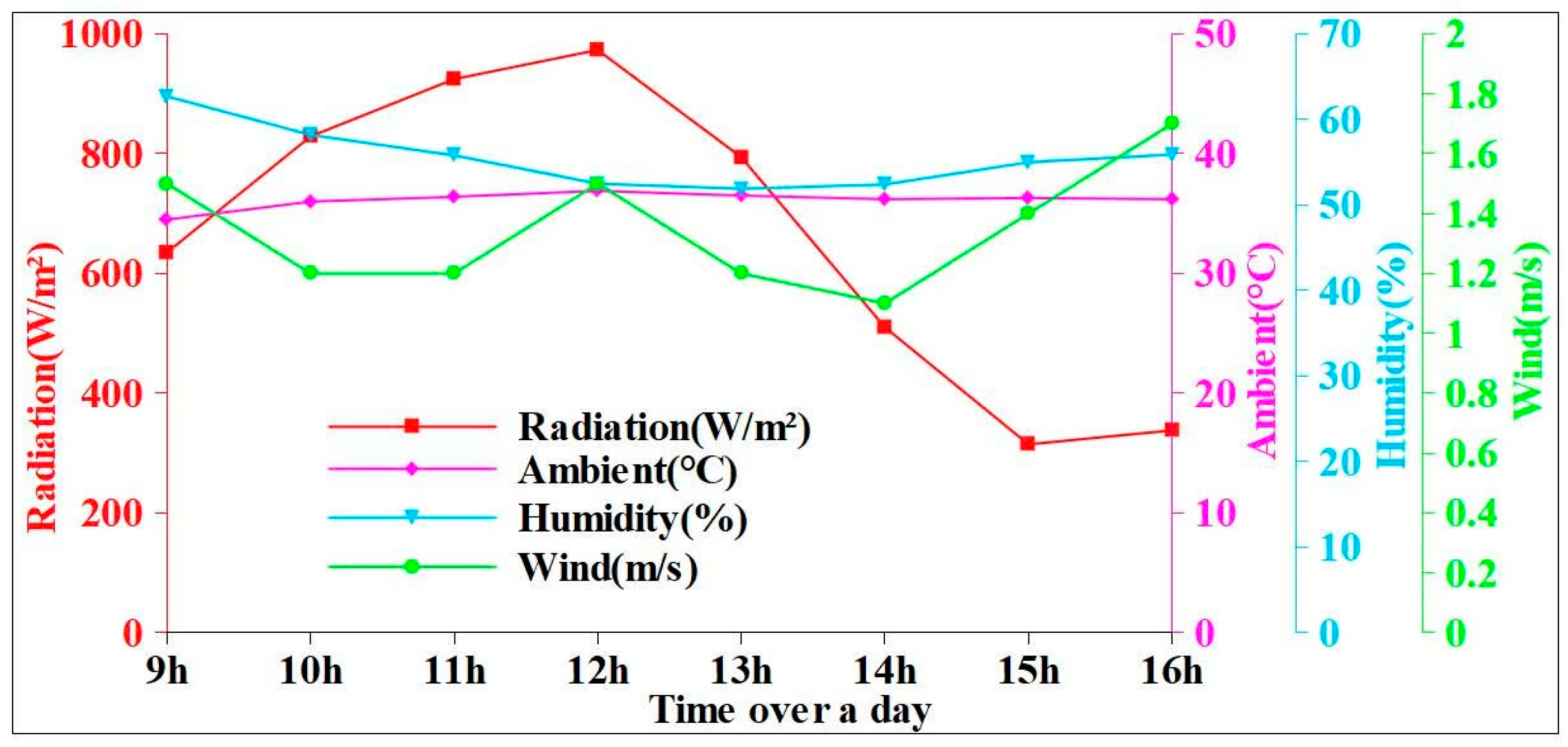
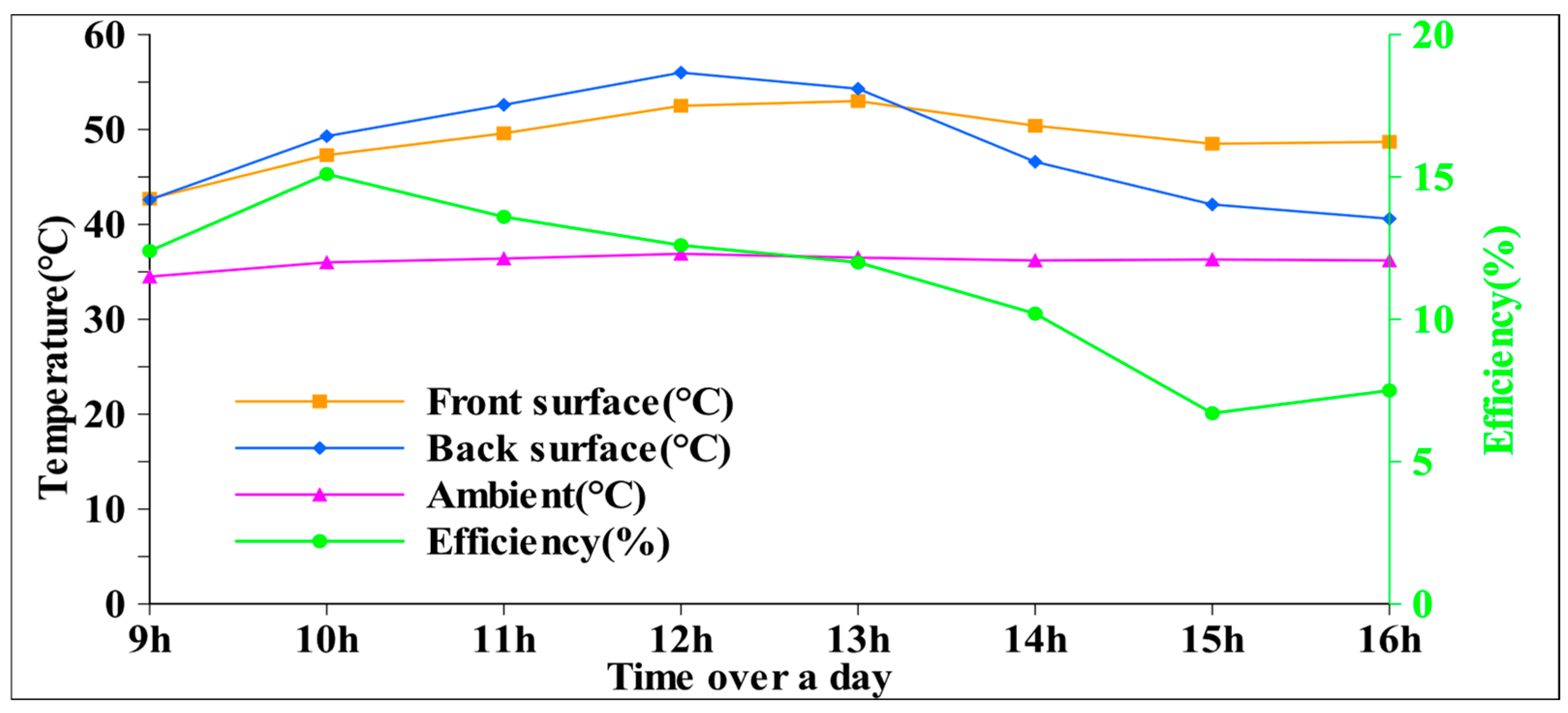

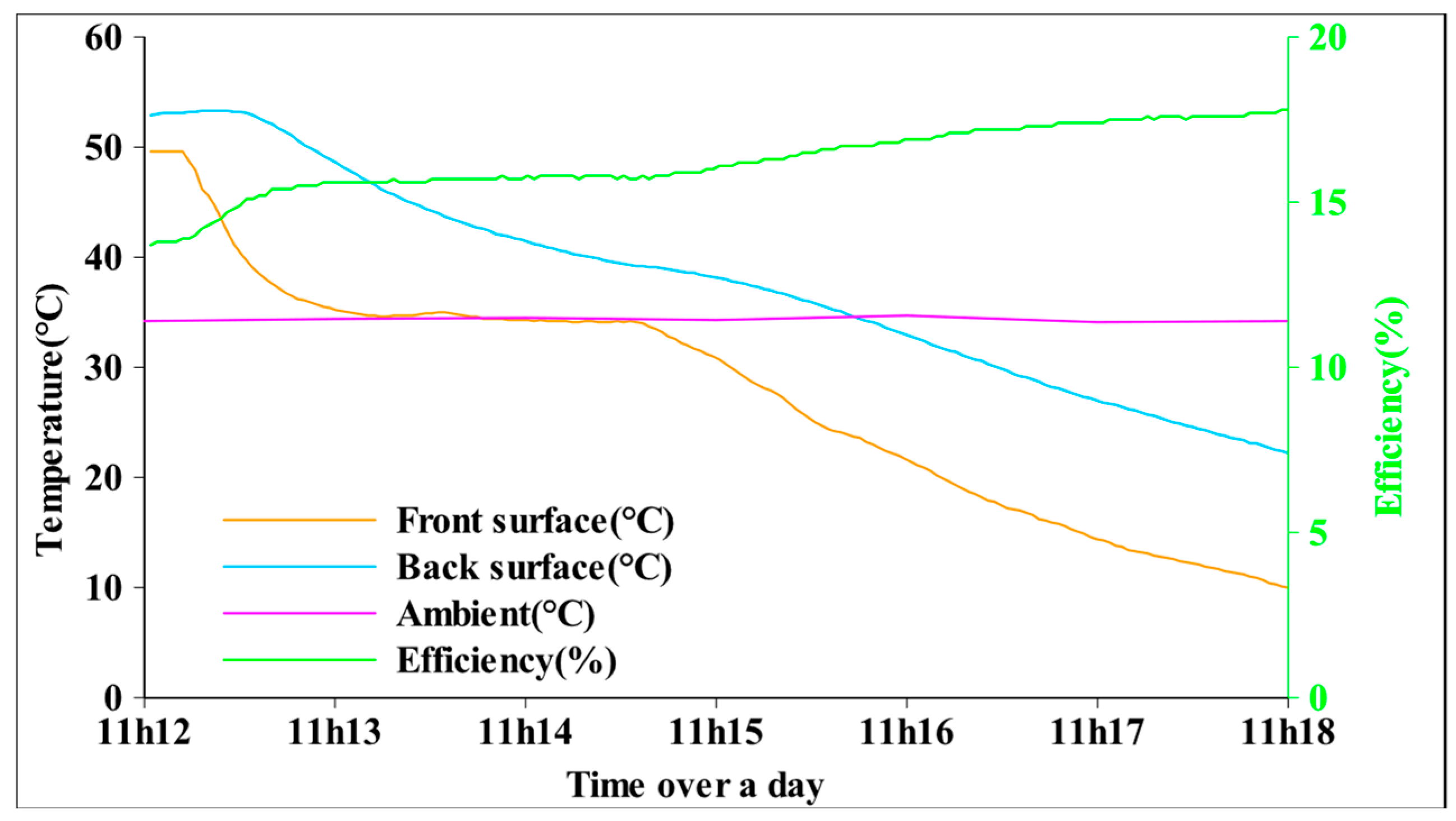
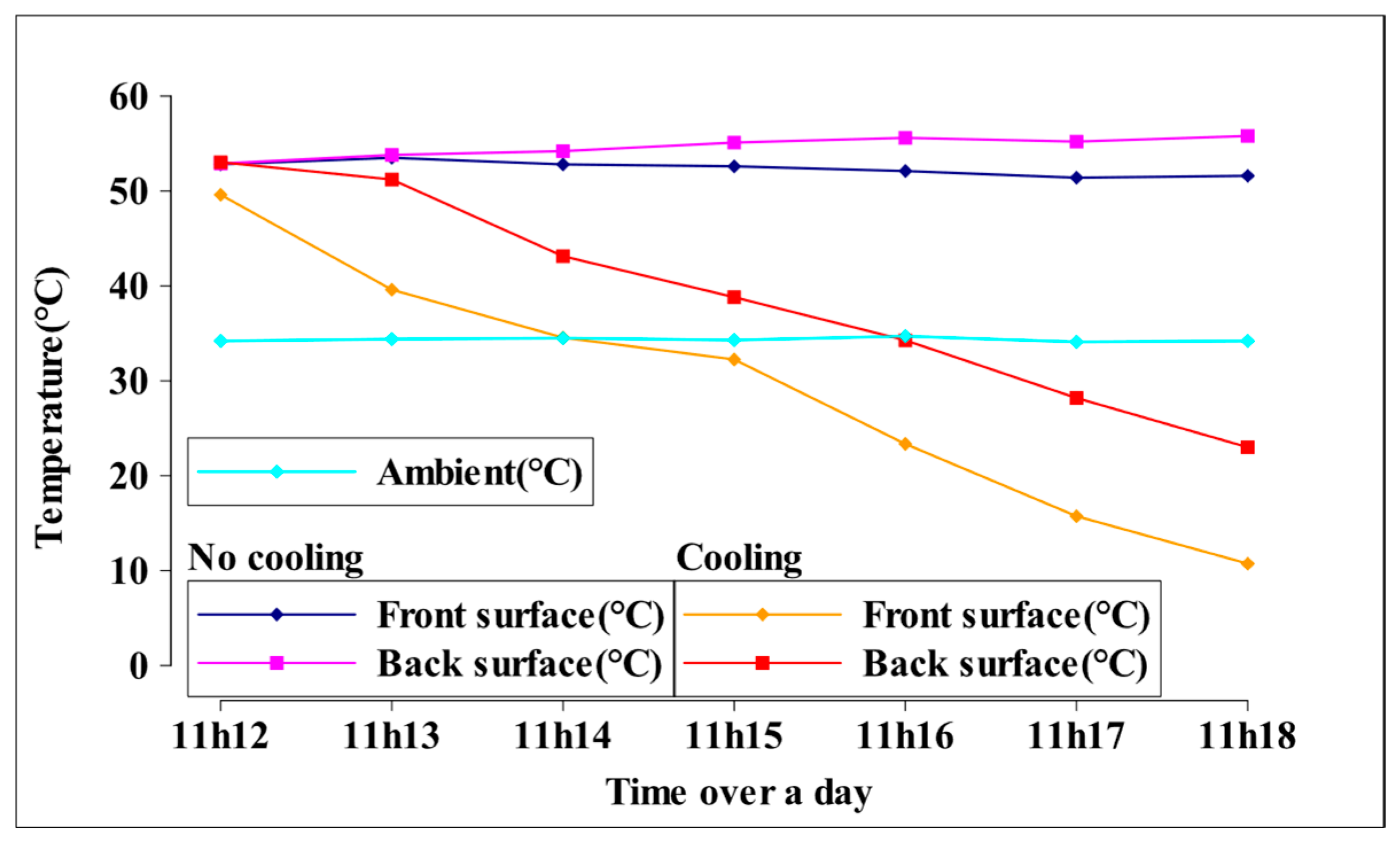
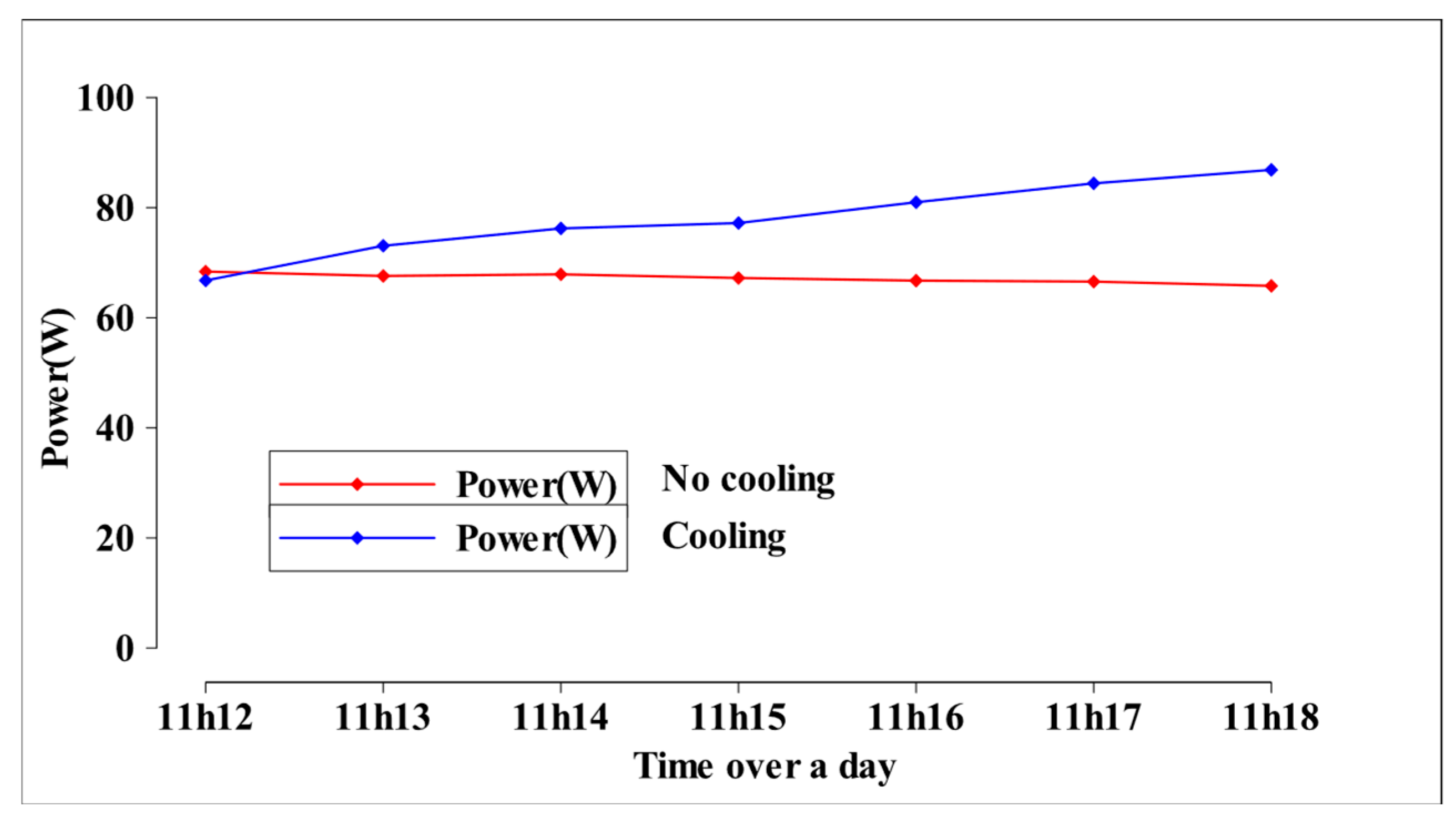
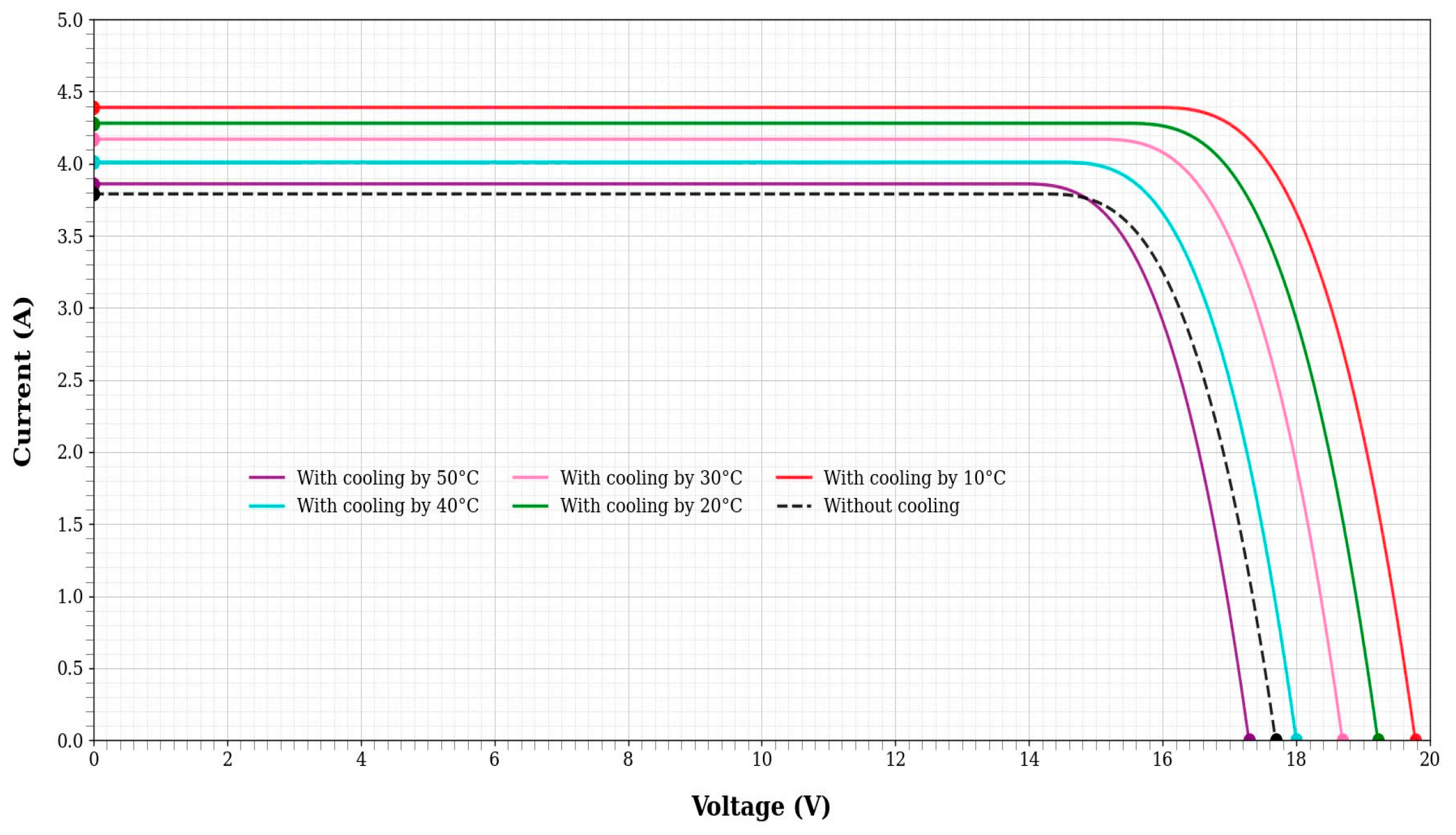
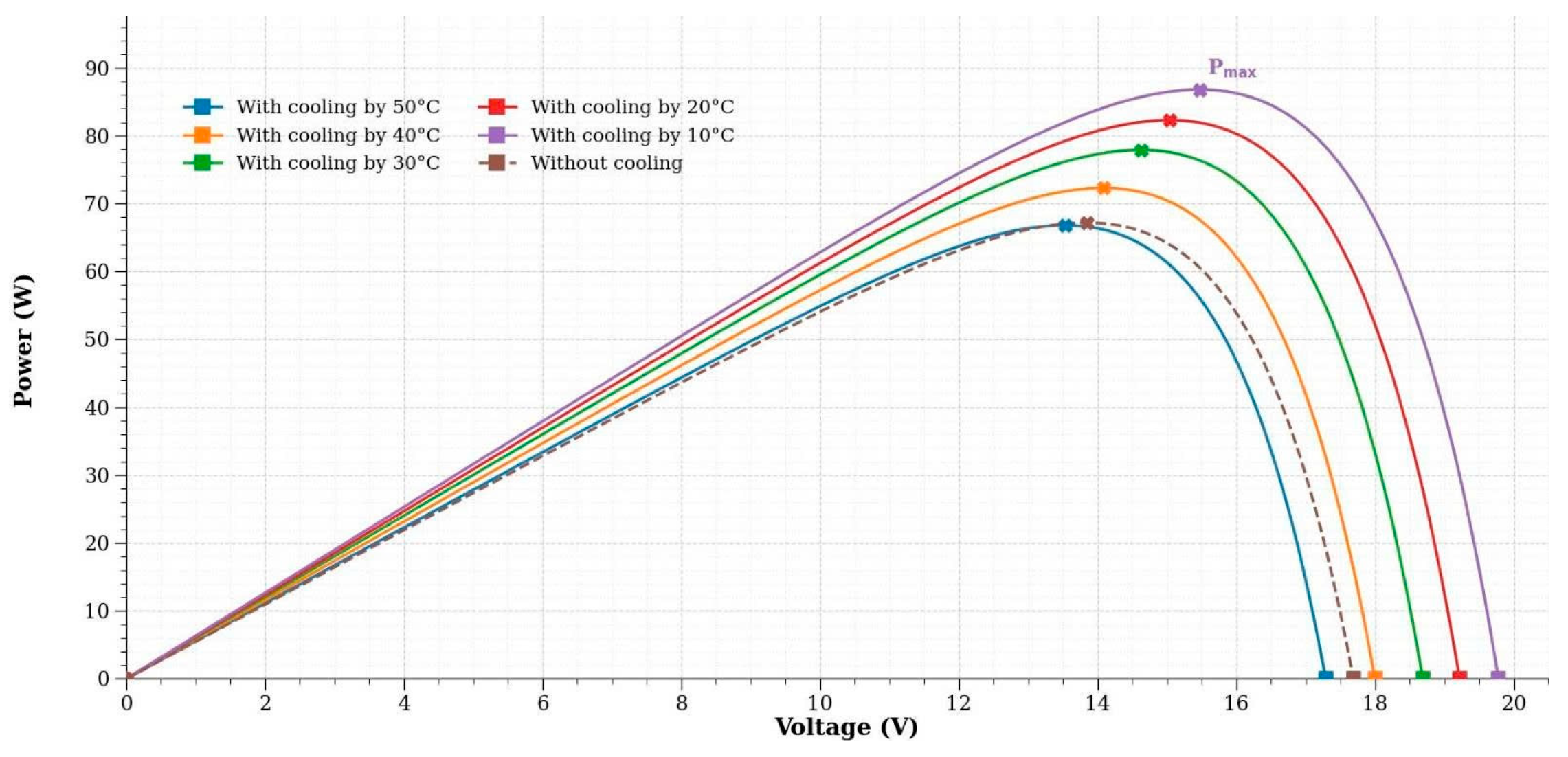
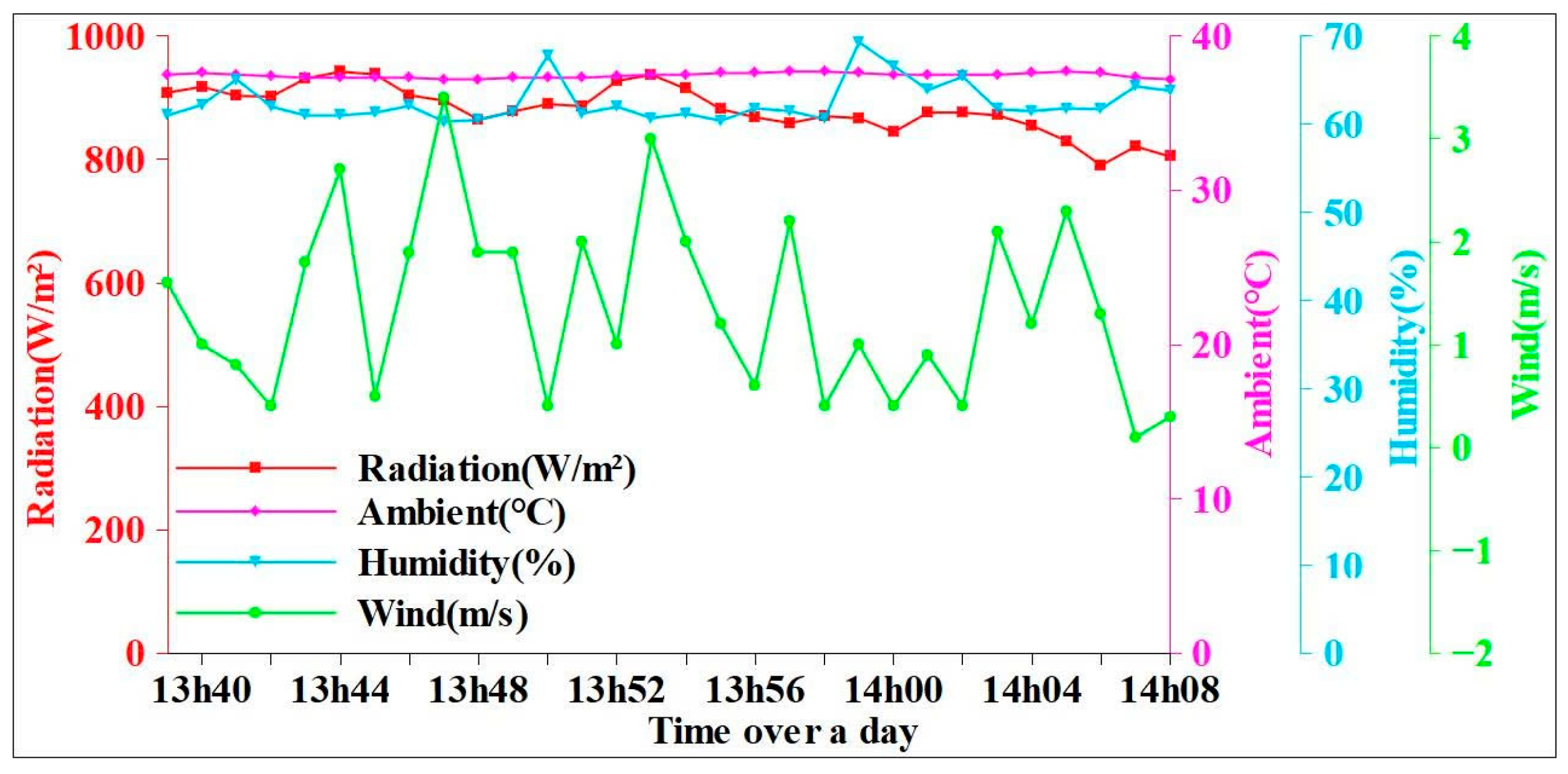

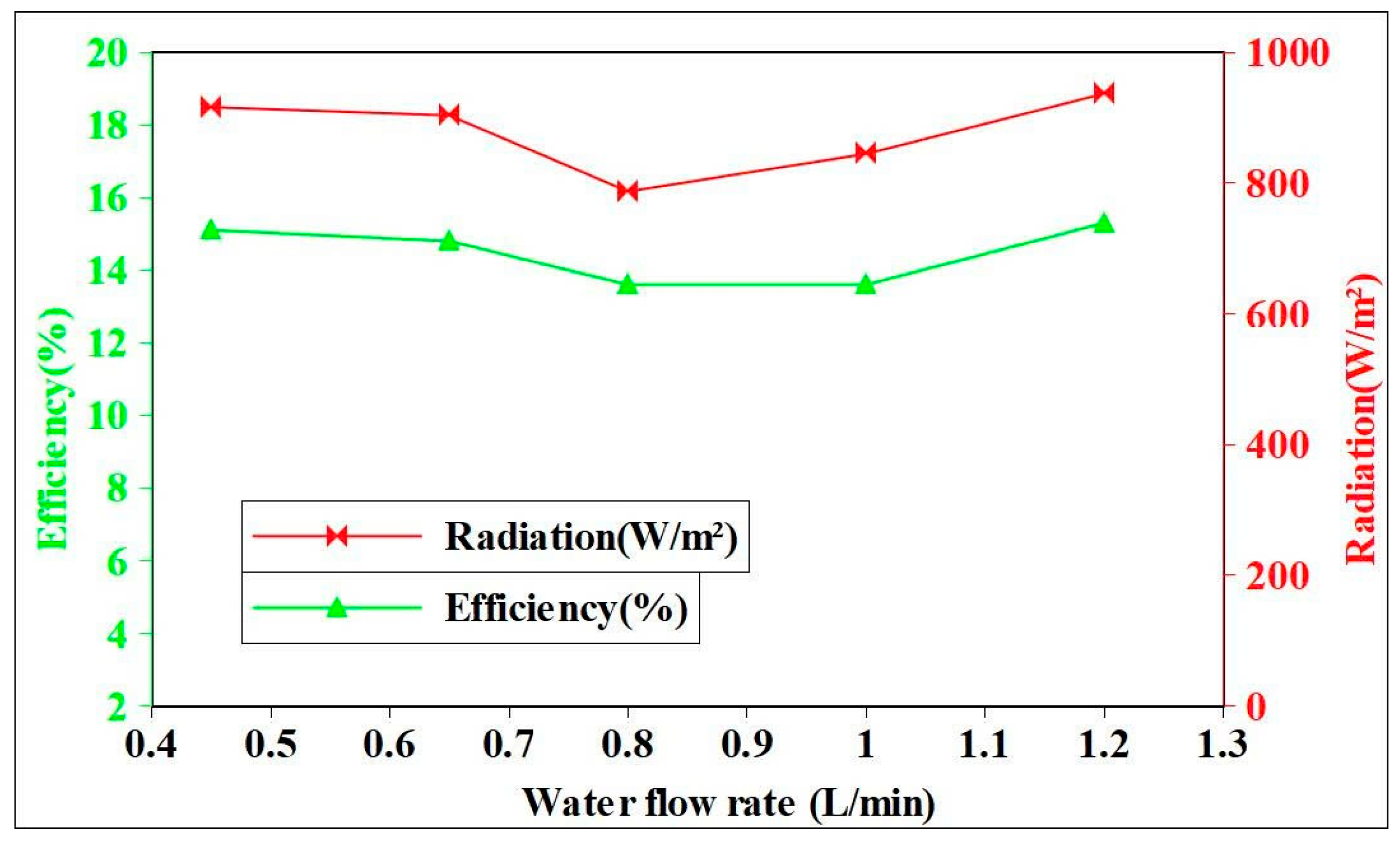
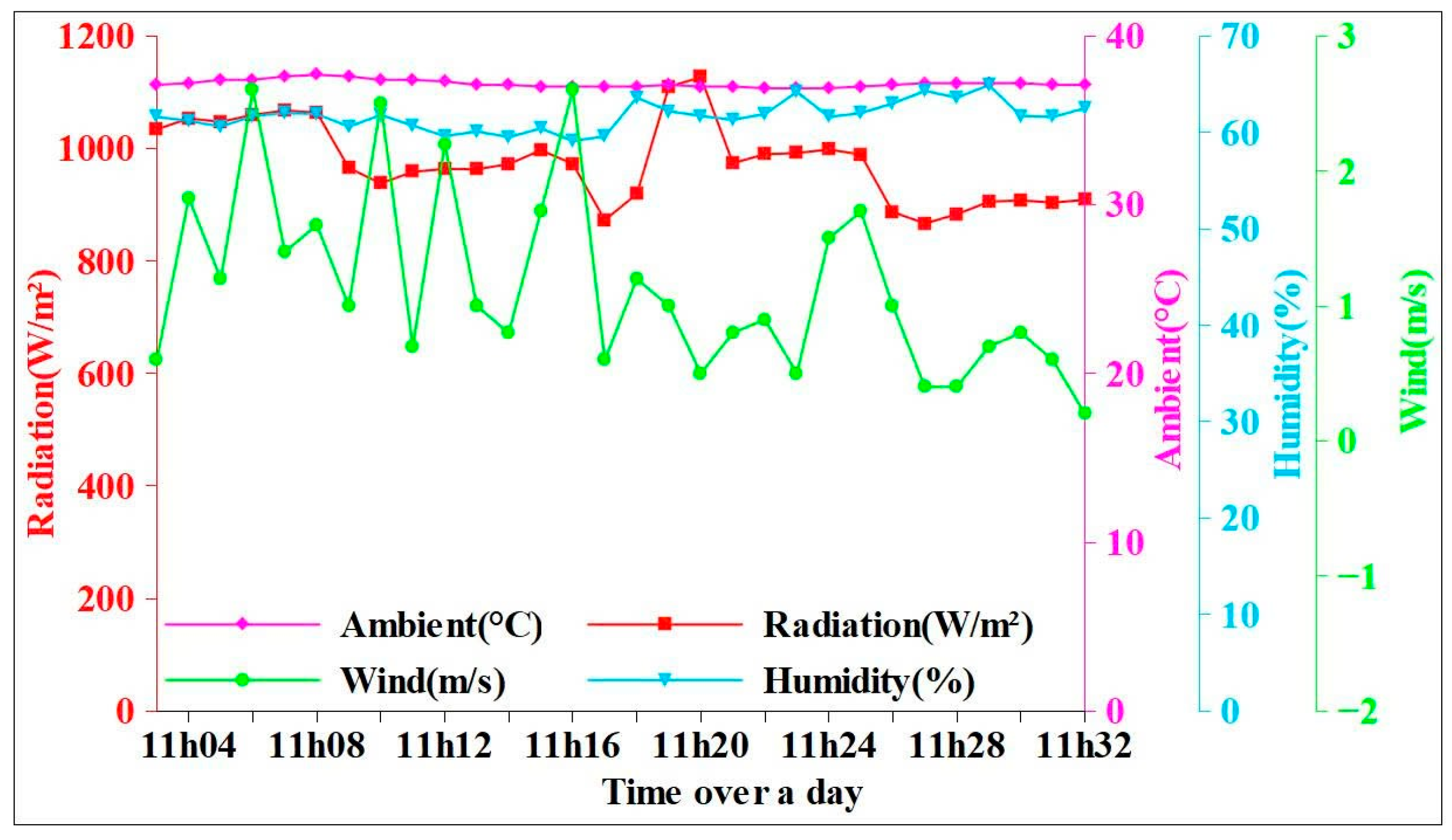

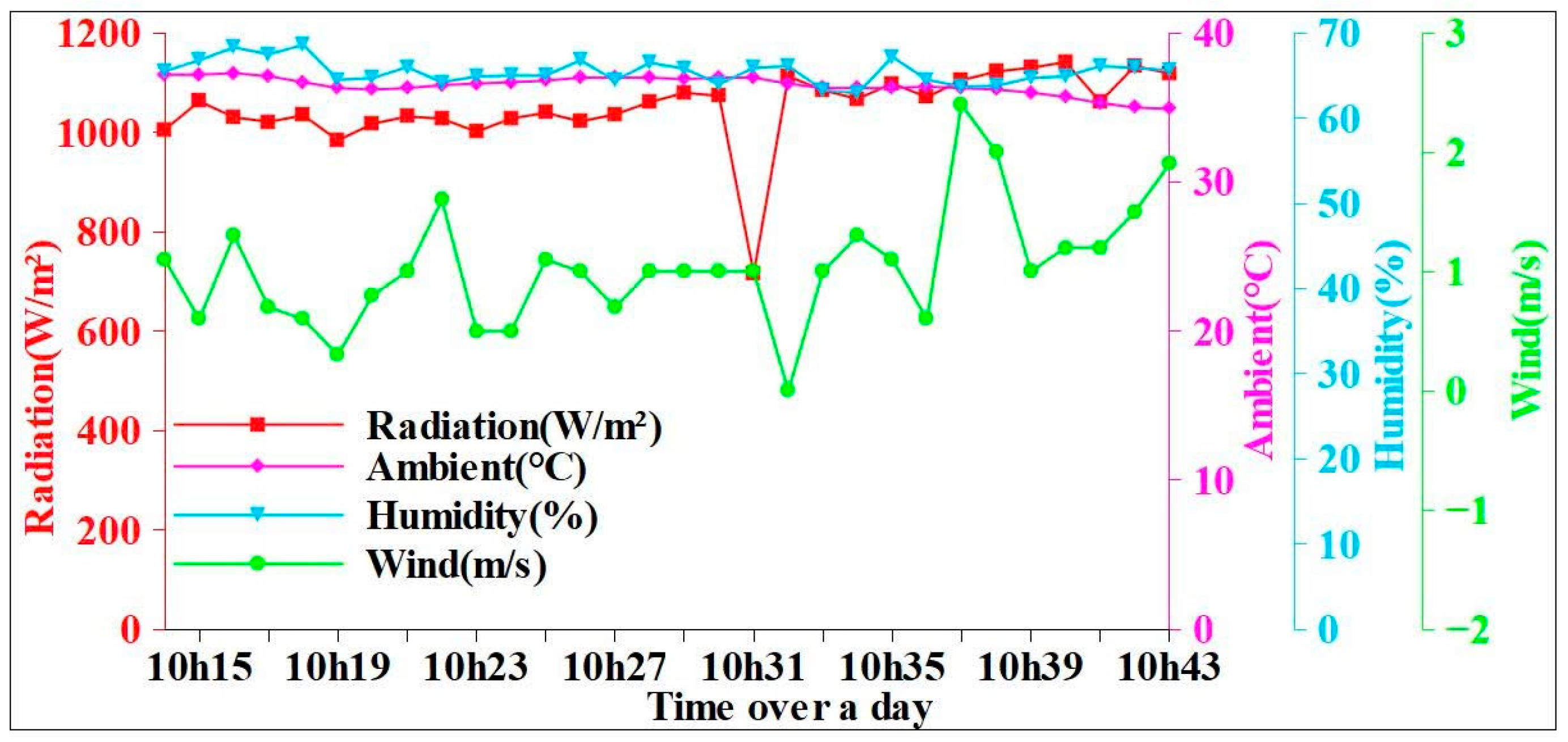
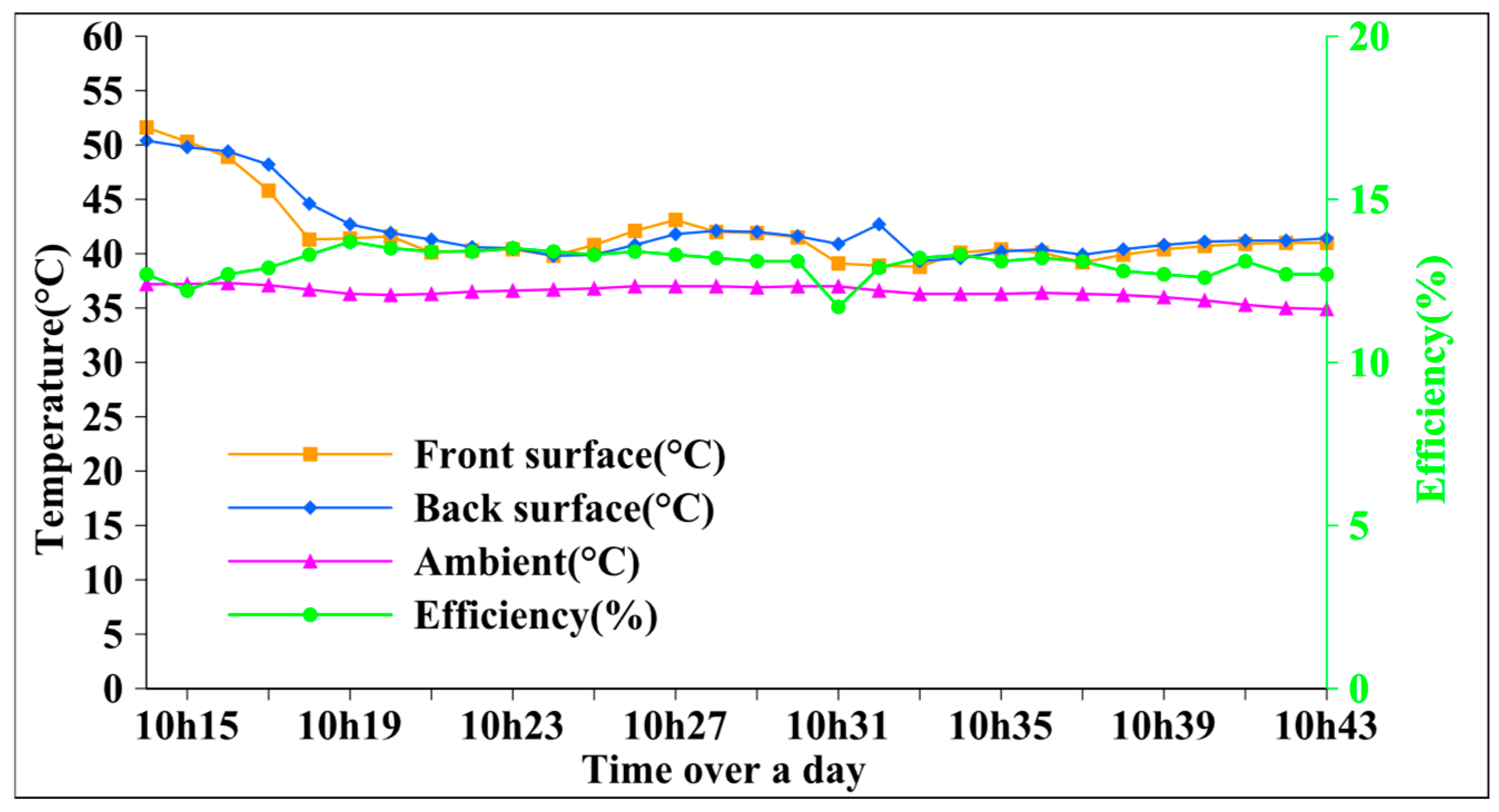
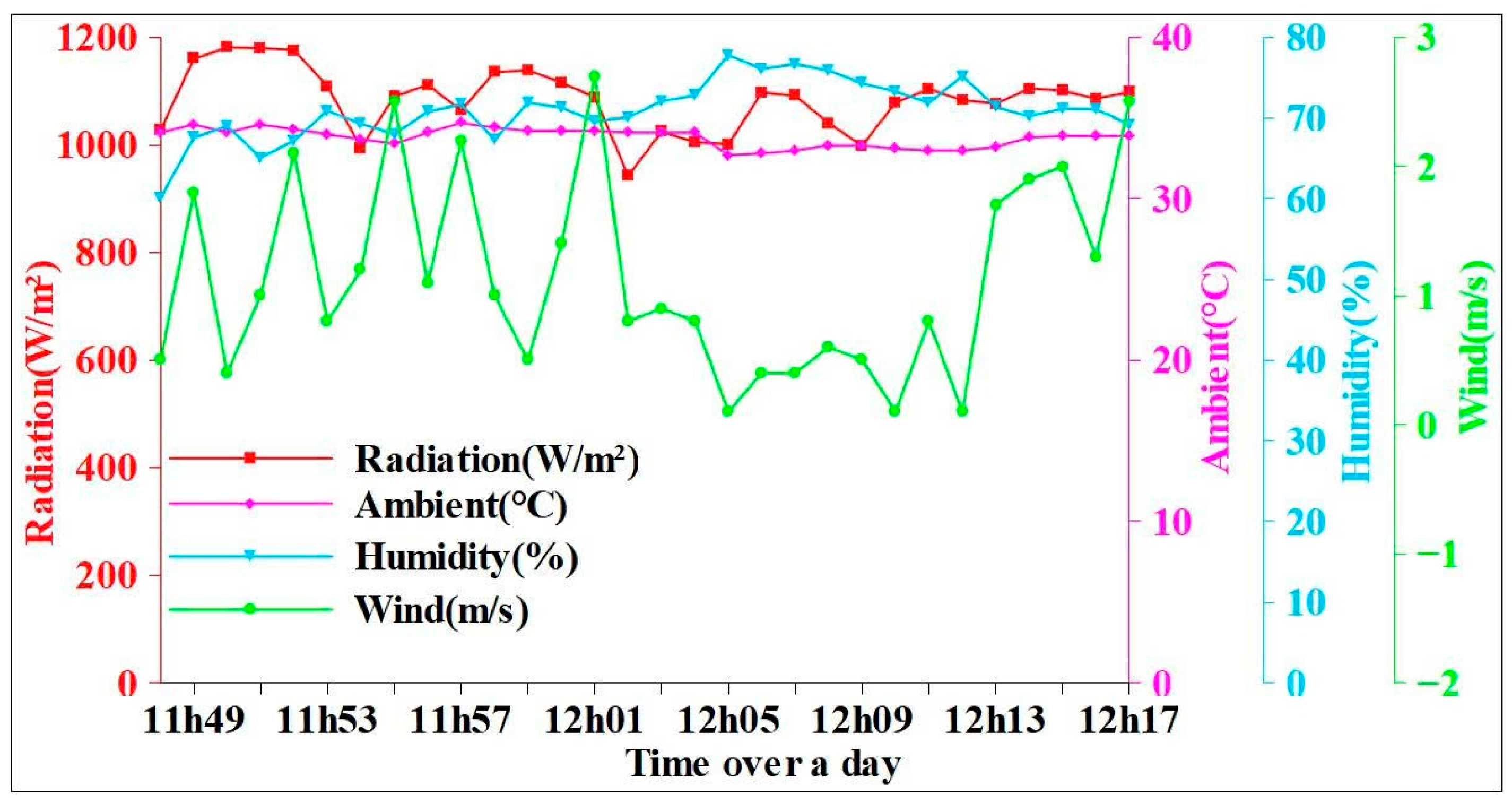

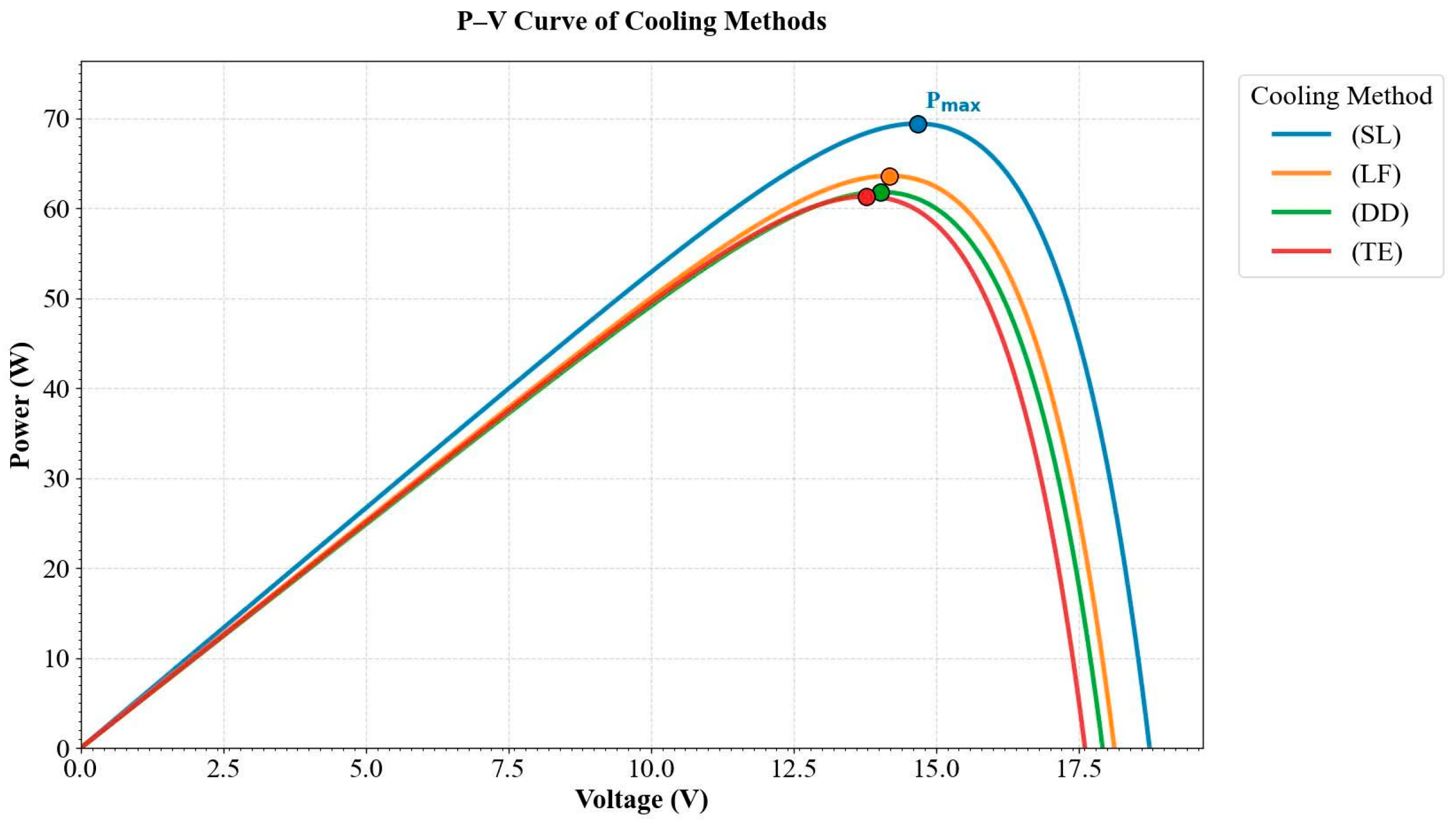
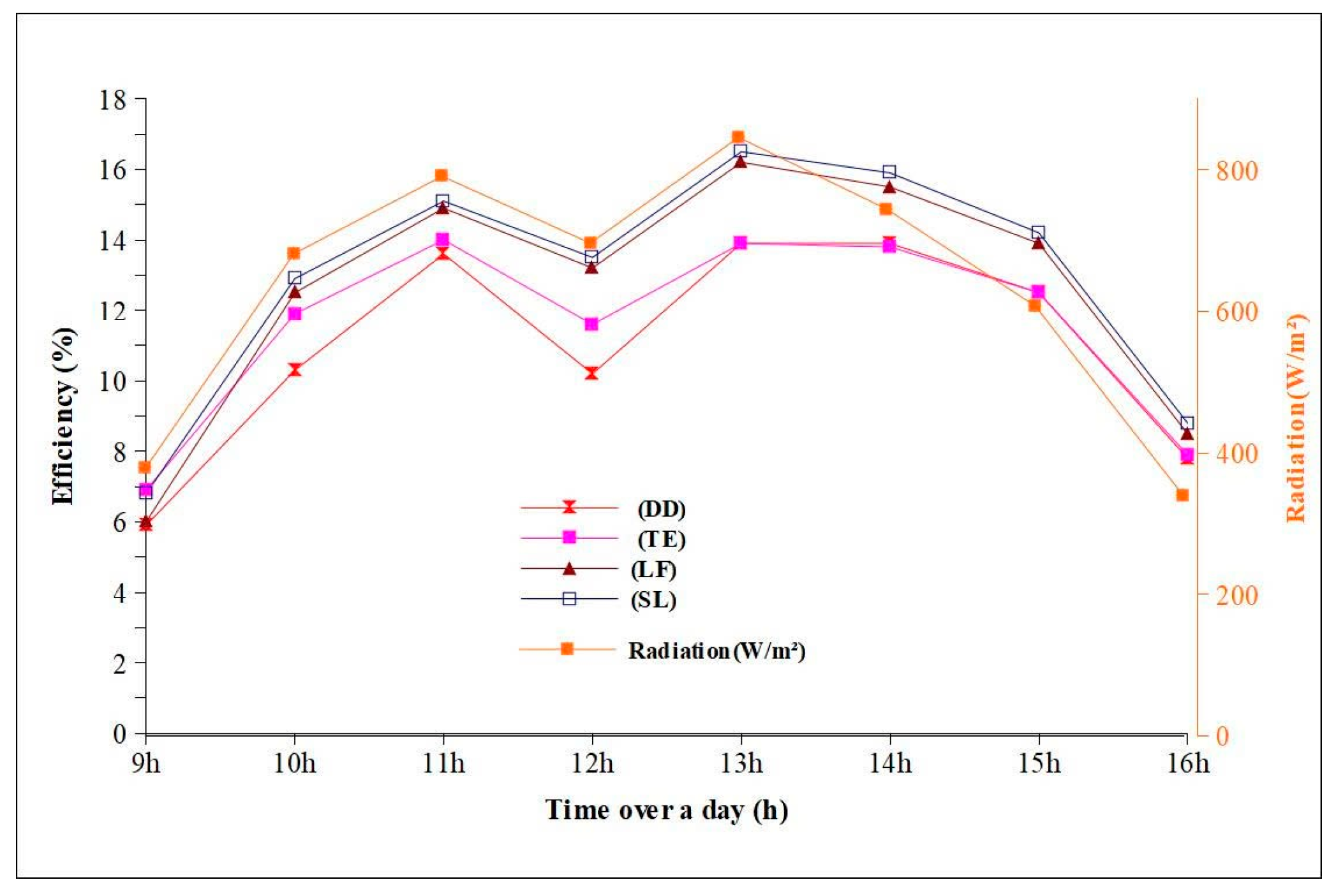
| No | Device/ Sensor | Model (Company) | Main Chip | Supply Voltage | Measurement Range | Accuracy | Dimensions |
|---|---|---|---|---|---|---|---|
| 1 | Temperature Sensor (Panel Surface) | DS18B20 (Maxim Integrated Company, USA) | 18B20 | 3.0–5.5 V | −55 °C to +125 °C | ±0.5 °C | 28 × 12 × 10 mm |
| 2 | Ambient Temperature and Humidity Sensor | SHT30 (Sensirion company, Swiss) | CMOS | 2.15–5.5 V | Temp: −40 °C to +125 °C; Humidity: 0–100% RH | ±0.2 °C, ±2% RH | ~30–50 × 10–15 × 10 mm |
| 3 | Wind Velocity Sensor | Anemometer DC5–30 V | Magnetic/ Optical Sensor | 5–30 V | 0–30 m/s (up to 45 m/s) | ±3% or ±0.3 m/s | 100–150 mm × 200–300 mm |
| 4 | Current and Voltage Measurement Sensor | INA219 (Texas Instruments company) | Precision Amplifier + ADC | 3.0–5.5 V | Voltage: 0–26 V; Current: up to ±3.2 A | ±1% (full range), ±0.5% (25 °C) | 25.6 × 20.4 × 4.7 mm |
| 5 | Data Storage Module | SD Card Module SPI | Logic Level Converter | 3.3–5 V | Digital storage | Depends on SD card quality | 51 × 30 × 4 mm |
| 6 | Microcontroller Unit | Arduino Mega2560 R3 | ATmega2560 | 5 V (USB or regulated), 7–12 V DC input | - | ADC: ±2 LSB | 101.52 × 53.3 × 15 mm |
| 7 | Display Module | LCD 20 × 4 (with I2C) | HD44780 Compatible | 5 V | 20 characters × 4 lines | Depends on input data | 98 × 60 × 14 mm |
| 8 | Real-Time Clock Module | DS3231 | DS3231 + AT24C32 | 2.3–5.5 V | Time tracking | ±2 ppm (~1–2 min/year at 25 °C) | 38 × 22 × 14 mm |
| 9 | Solar Radiation Measurement Panel | Mini Solar Panel 6 V/3 W | Silicon Solar Cell | Nominal 6 V | Vmp: ~6 V; Voc: ~7.2 V; Imp: ~0.5 A; Isc: ~0.55 A | ±5% | 145 × 145 × 3 mm |
| 10 | Current Sensor (ACS712) | ACS712 (Allegro MicroSystems) | ACS712 | 4.5–5.5 V | Current: ±5 A, ±20 A, ±30 A | ±1.5% | 31 × 13 × 13 mm |
| Cooling Method | PV Surface Temperature Reduction | Power Conversion Efficiency | Water Consumption | Key Remarks |
|---|---|---|---|---|
| Spraying Liquid Method (SL) | Decrease from ~50° C to 33 °C (front), 48 °C to 34 °C (rear) | Increase from ~12% to ~15%; stabilized at 14.8–15.2% | 0.45–1.2 L/min; optimum at ~0.65 L/min | Provides rapid cooling and maintains stable efficiency; performance is more sensitive to irradiance than to flow rate. |
| Tube Heat Exchanger Method (TE) | Slight reduction of 2–3 °C compared with no cooling | Efficiency fluctuates between 13 and 14%, peaked at 14.8% temporarily | ~1.8 L/min (~54 L/30 min) | Limited effectiveness due to small contact area of copper tube with PV back surface; requires design improvements to enhance heat transfer. |
| Droplet Dripping Method (DD) | Reduction from ~50 °C to ~40 °C | Improvement from 12 to 12.5% - ~13.5% | ~1 L/min | Efficiency increases by ~0.1% per 1 °C temperature reduction; continuous water demand results in high operational cost. |
| Liquid flowing on the PV surface method (LF) | Rapid decrease from >50 °C to ~35 °C | Improvement from 12.5% to 14% (+1.5%) | ~98 L/30 min (~3.27 L/min) | Provides effective cooling and notable efficiency gain; excessive water consumption necessitates recovery and recirculation systems. |
Disclaimer/Publisher’s Note: The statements, opinions and data contained in all publications are solely those of the individual author(s) and contributor(s) and not of MDPI and/or the editor(s). MDPI and/or the editor(s) disclaim responsibility for any injury to people or property resulting from any ideas, methods, instructions or products referred to in the content. |
© 2025 by the authors. Licensee MDPI, Basel, Switzerland. This article is an open access article distributed under the terms and conditions of the Creative Commons Attribution (CC BY) license (https://creativecommons.org/licenses/by/4.0/).
Share and Cite
Nguyen, N.Q.; Beloev, H.I.; Nguyen, H.B.; Nguyen, V.L. Experimental Comparison of Water-Based Cooling Methods for PV Modules in Tropical Conditions. Energies 2025, 18, 5054. https://doi.org/10.3390/en18195054
Nguyen NQ, Beloev HI, Nguyen HB, Nguyen VL. Experimental Comparison of Water-Based Cooling Methods for PV Modules in Tropical Conditions. Energies. 2025; 18(19):5054. https://doi.org/10.3390/en18195054
Chicago/Turabian StyleNguyen, Nam Quyen, Hristo Ivanov Beloev, Huy Bich Nguyen, and Van Lanh Nguyen. 2025. "Experimental Comparison of Water-Based Cooling Methods for PV Modules in Tropical Conditions" Energies 18, no. 19: 5054. https://doi.org/10.3390/en18195054
APA StyleNguyen, N. Q., Beloev, H. I., Nguyen, H. B., & Nguyen, V. L. (2025). Experimental Comparison of Water-Based Cooling Methods for PV Modules in Tropical Conditions. Energies, 18(19), 5054. https://doi.org/10.3390/en18195054






